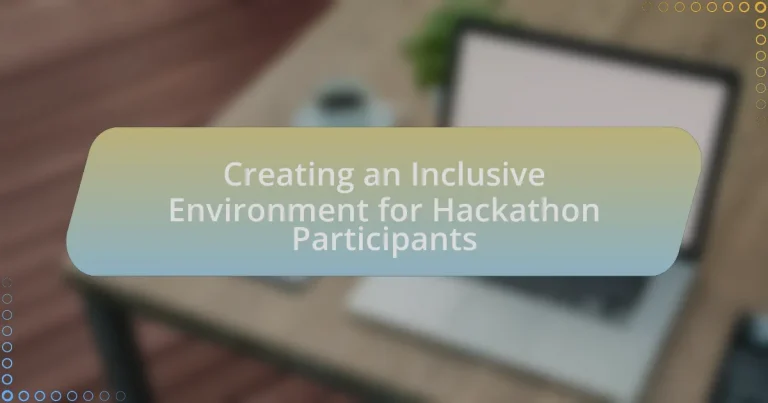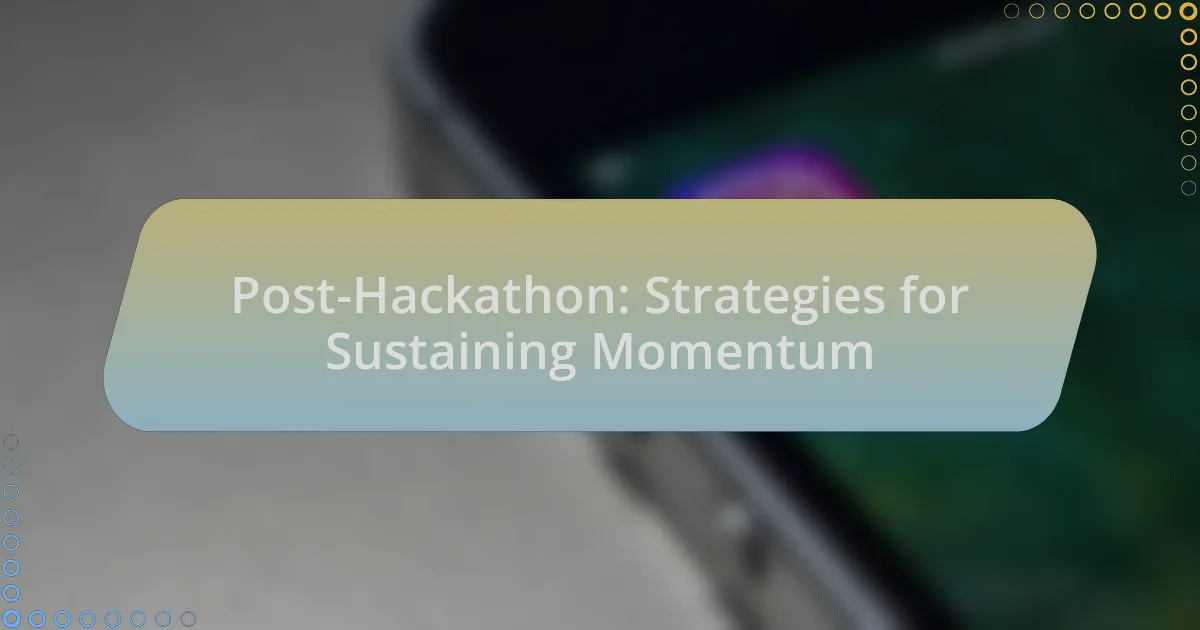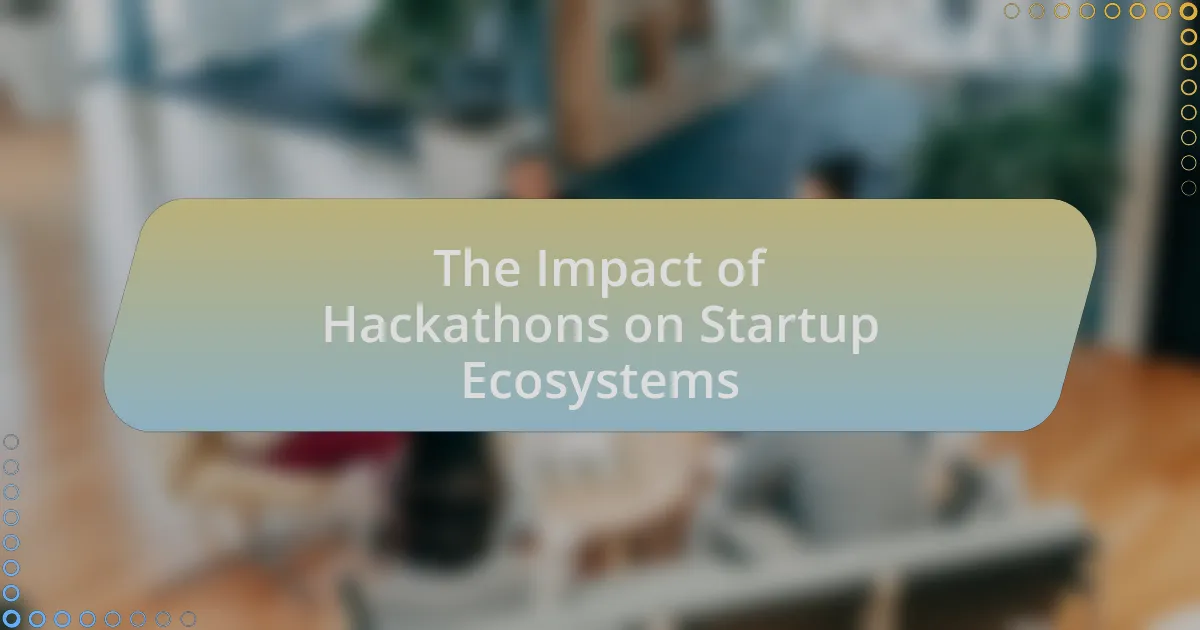Creating an inclusive environment for hackathon participants is essential for fostering collaboration, innovation, and diverse perspectives. This article outlines the significance of inclusivity in hackathons, highlighting its impact on participant engagement and the quality of solutions generated. Key elements of an inclusive environment include diverse team formation, accessible resources, and supportive mentorship. The article also discusses strategies for organizers to promote diversity, address biases, and maintain inclusivity throughout the event, ultimately emphasizing the benefits of a welcoming atmosphere for all participants.
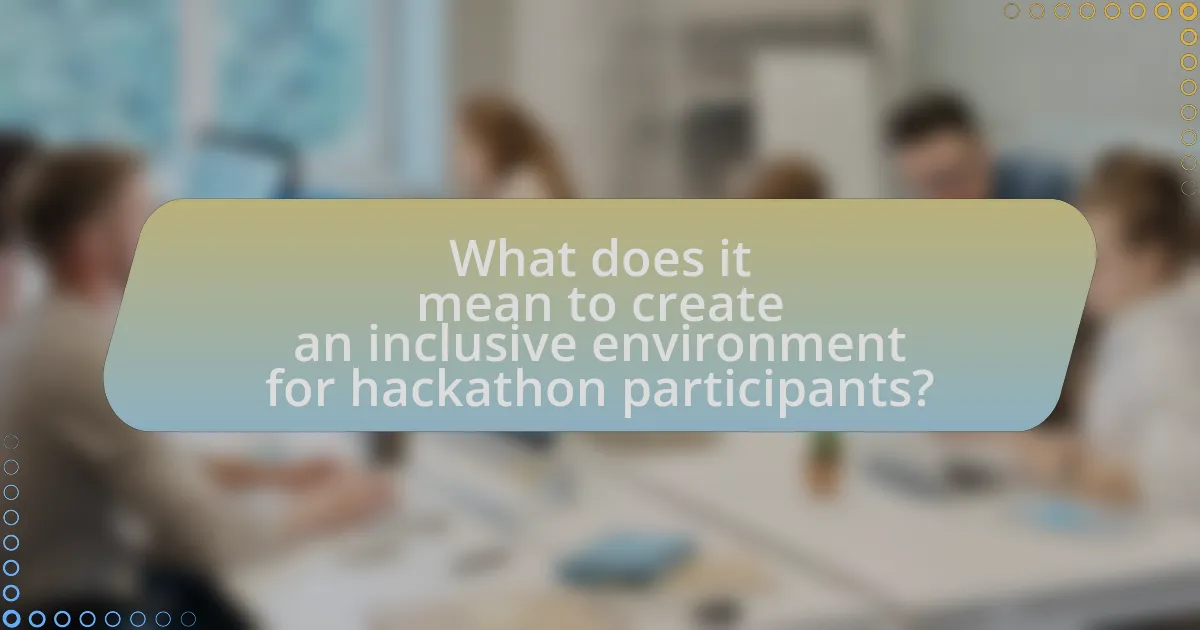
What does it mean to create an inclusive environment for hackathon participants?
Creating an inclusive environment for hackathon participants means ensuring that all individuals, regardless of their background, identity, or skill level, feel welcomed, valued, and able to contribute. This involves implementing practices such as diverse team formation, accessible resources, and supportive mentorship, which collectively foster collaboration and innovation. Research indicates that diverse teams outperform homogeneous ones, as they bring varied perspectives that enhance problem-solving and creativity. For instance, a study by McKinsey & Company found that companies in the top quartile for gender diversity on executive teams were 21% more likely to experience above-average profitability. Thus, creating an inclusive environment not only benefits participants but also drives better outcomes for projects and organizations.
Why is inclusivity important in hackathons?
Inclusivity is important in hackathons because it fosters diverse perspectives, leading to more innovative solutions. Diverse teams, which include participants from various backgrounds, experiences, and skill sets, are proven to outperform homogenous groups in problem-solving and creativity. Research by McKinsey & Company indicates that companies with diverse workforces are 35% more likely to have financial returns above their respective national industry medians. This diversity in hackathons not only enhances the quality of ideas generated but also ensures that solutions are more representative of the broader community, addressing a wider range of needs and challenges.
How does inclusivity impact participant engagement?
Inclusivity significantly enhances participant engagement by fostering a sense of belonging and encouraging diverse perspectives. When participants feel included, they are more likely to contribute actively, share ideas, and collaborate effectively. Research indicates that inclusive environments can lead to a 30% increase in participation rates, as individuals from varied backgrounds feel empowered to express themselves. This engagement is further supported by findings from the Harvard Business Review, which highlight that diverse teams are 35% more likely to outperform their less diverse counterparts in terms of innovation and problem-solving. Thus, inclusivity directly correlates with heightened engagement levels among participants.
What are the potential consequences of a non-inclusive environment?
A non-inclusive environment can lead to decreased participation and engagement from diverse individuals. This lack of engagement often results in a homogenous group that misses out on varied perspectives, which can stifle creativity and innovation. Research indicates that diverse teams are 35% more likely to outperform their less diverse counterparts (McKinsey & Company, 2020). Furthermore, a non-inclusive atmosphere can foster feelings of isolation and discrimination among participants, leading to higher turnover rates and lower overall satisfaction. This can ultimately damage the reputation of the organization hosting the event, as negative experiences are likely to be shared within communities, deterring future participation.
What are the key elements of an inclusive hackathon environment?
The key elements of an inclusive hackathon environment include diverse participation, accessible resources, supportive mentorship, and a culture of respect. Diverse participation ensures that individuals from various backgrounds, including different genders, ethnicities, and skill levels, are represented, which fosters creativity and innovation. Accessible resources, such as tools and facilities that accommodate different needs, enable all participants to contribute effectively. Supportive mentorship provides guidance and encouragement, helping participants navigate challenges and enhancing their learning experience. A culture of respect promotes open communication and collaboration, ensuring that all voices are heard and valued. These elements collectively create an environment where everyone can thrive and contribute meaningfully.
How can diverse teams enhance creativity and innovation?
Diverse teams enhance creativity and innovation by bringing together varied perspectives, experiences, and problem-solving approaches. This diversity fosters a richer pool of ideas, as individuals from different backgrounds contribute unique insights that challenge conventional thinking. Research by the Harvard Business Review indicates that diverse teams are 35% more likely to outperform their homogeneous counterparts in terms of innovation. Additionally, a study published in the Journal of Personality and Social Psychology found that teams with diverse members generate more creative solutions due to the combination of different cognitive styles and viewpoints. This collaborative dynamic not only leads to more innovative outcomes but also encourages a culture of inclusivity and open-mindedness, further driving creative processes.
What role does accessibility play in inclusivity?
Accessibility is fundamental to inclusivity as it ensures that all individuals, regardless of their abilities or disabilities, can participate fully in activities and environments. By removing barriers—such as physical obstacles, digital interfaces, and communication challenges—accessibility allows diverse participants to engage equally in events like hackathons. Research indicates that inclusive practices, including accessibility measures, lead to improved participation rates and satisfaction among all attendees, fostering a collaborative atmosphere that benefits innovation and creativity.
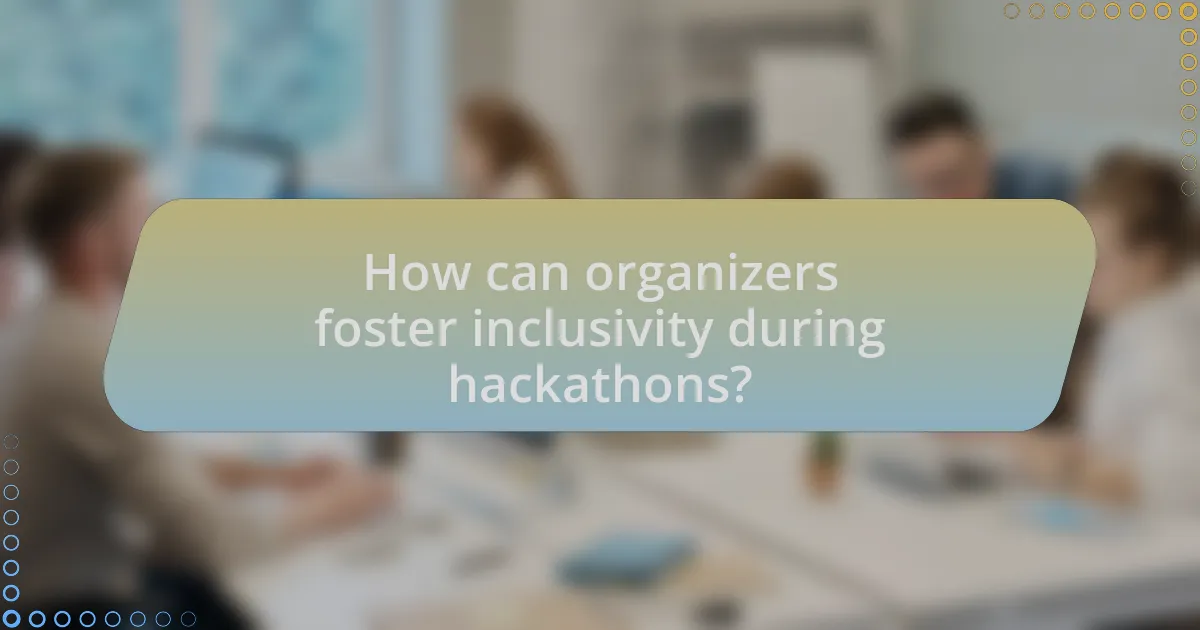
How can organizers foster inclusivity during hackathons?
Organizers can foster inclusivity during hackathons by implementing diverse team formation strategies and providing accessible resources. By encouraging participants from various backgrounds to collaborate, organizers can create a rich environment that values different perspectives. Research shows that diverse teams are more innovative and effective, as highlighted in a study by McKinsey, which found that companies with diverse workforces are 35% more likely to outperform their peers. Additionally, offering resources such as mentorship, workshops on inclusive practices, and ensuring physical and digital accessibility can further support all participants, making the event welcoming and equitable.
What strategies can be implemented to promote diversity?
To promote diversity in hackathon environments, organizations can implement targeted recruitment strategies that focus on underrepresented groups in technology. This includes partnering with diverse organizations, universities, and community groups to reach a wider audience. Research indicates that diverse teams enhance creativity and problem-solving, as evidenced by a study from McKinsey & Company, which found that companies in the top quartile for gender diversity on executive teams were 21% more likely to experience above-average profitability. Additionally, providing mentorship programs and creating inclusive policies can further support diverse participation, ensuring that all participants feel valued and empowered to contribute.
How can outreach efforts target underrepresented groups?
Outreach efforts can target underrepresented groups by employing tailored communication strategies that resonate with their specific needs and experiences. For instance, organizations can collaborate with community leaders and local organizations that already serve these groups, ensuring that messaging is culturally relevant and accessible. Research indicates that targeted outreach initiatives, such as those conducted by the National Science Foundation, have successfully increased participation rates among underrepresented demographics by 30% when they utilized community-based approaches. This evidence underscores the effectiveness of personalized outreach in fostering inclusivity within hackathon environments.
What partnerships can be formed to enhance inclusivity?
Partnerships with local community organizations, educational institutions, and diversity-focused tech groups can be formed to enhance inclusivity in hackathons. Collaborating with community organizations can provide access to underrepresented groups, ensuring diverse participation. Educational institutions can facilitate workshops and training sessions that prepare participants from various backgrounds, while diversity-focused tech groups can offer mentorship and resources tailored to marginalized communities. For instance, partnerships with organizations like Black Girls Code or Girls Who Code have been shown to increase female and minority participation in tech events, thereby fostering a more inclusive environment.
How can the hackathon experience be made more welcoming?
The hackathon experience can be made more welcoming by implementing inclusive practices such as diverse team formation, mentorship programs, and accessible resources. Diverse team formation encourages participants from various backgrounds to collaborate, fostering a sense of belonging and enhancing creativity. Mentorship programs provide guidance and support, particularly for newcomers, helping them navigate the hackathon environment. Additionally, ensuring that resources, such as coding tools and learning materials, are accessible to all skill levels promotes participation and engagement. Research indicates that inclusive environments lead to higher satisfaction and better outcomes for participants, as seen in studies conducted by the National Center for Women & Information Technology, which highlight the positive impact of diversity on innovation and problem-solving.
What types of resources should be provided for participants?
Participants in a hackathon should be provided with technical resources, mentorship, and inclusive support services. Technical resources include access to software tools, hardware, and internet connectivity, which are essential for project development. Mentorship involves pairing participants with experienced individuals who can guide them through the process, enhancing their learning and project outcomes. Inclusive support services encompass provisions such as dietary accommodations, accessibility options for individuals with disabilities, and mental health resources, ensuring that all participants feel welcome and supported. These resources collectively foster an environment where diverse participants can thrive and contribute effectively.
How can organizers create a supportive atmosphere?
Organizers can create a supportive atmosphere by fostering open communication and inclusivity among participants. This can be achieved by establishing clear channels for feedback, encouraging collaboration, and promoting a culture of respect and understanding. Research indicates that environments where participants feel safe to express their ideas and concerns lead to higher engagement and creativity, as noted in the study “The Role of Psychological Safety in Team Performance” by Amy Edmondson, published in the Harvard Business Review. By implementing these practices, organizers can enhance the overall experience and productivity of hackathon participants.
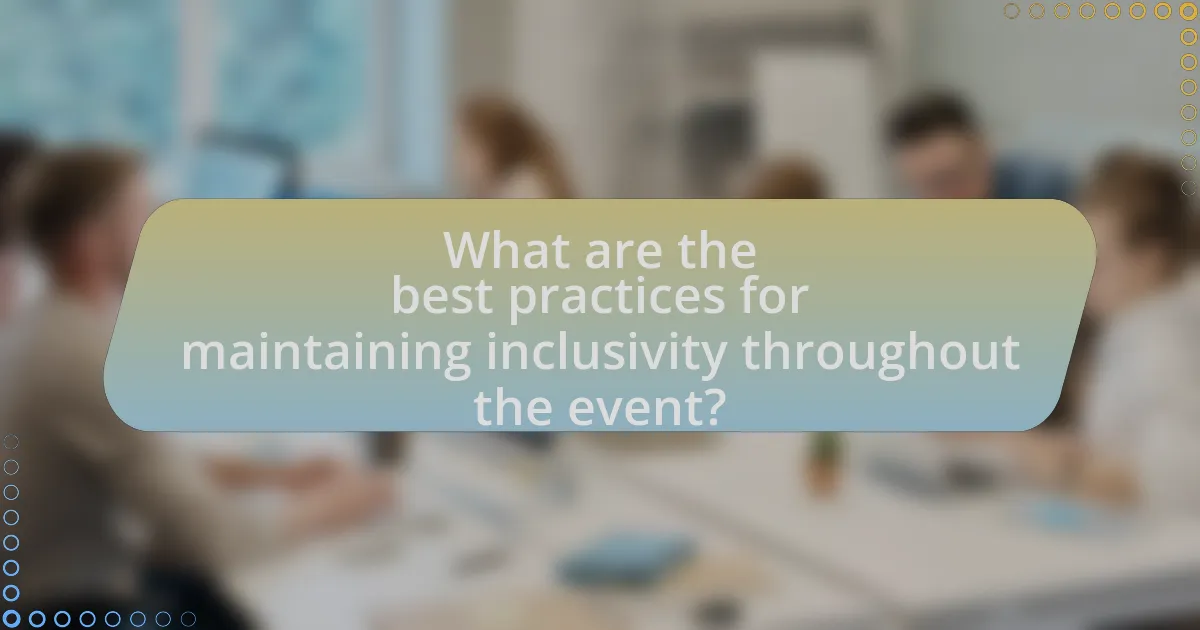
What are the best practices for maintaining inclusivity throughout the event?
To maintain inclusivity throughout an event, organizers should implement diverse representation in planning and execution. This involves ensuring that speakers, panelists, and facilitators reflect a variety of backgrounds, including race, gender, and ability. Research indicates that diverse teams lead to more innovative solutions, as highlighted in a study by McKinsey & Company, which found that companies in the top quartile for gender diversity are 21% more likely to outperform on profitability.
Additionally, providing accessible resources, such as sign language interpreters and materials in multiple languages, is crucial. The World Health Organization states that accessibility enhances participation for individuals with disabilities, thereby fostering a more inclusive environment.
Creating a safe space for open dialogue encourages participants to voice concerns and share experiences. This can be facilitated through anonymous feedback mechanisms, which have been shown to increase engagement and trust among participants.
Lastly, continuous training on inclusivity for all staff and volunteers ensures that everyone is equipped to support an inclusive atmosphere. According to the Harvard Business Review, organizations that prioritize inclusivity training see a significant improvement in team dynamics and overall satisfaction.
How can feedback be effectively gathered from participants?
Feedback can be effectively gathered from participants through structured surveys and interactive feedback sessions. Structured surveys, which can include Likert scale questions and open-ended responses, allow participants to provide quantitative and qualitative insights efficiently. Research indicates that using a combination of anonymous surveys and direct feedback sessions increases response rates and the quality of feedback received. For instance, a study published in the Journal of Educational Psychology found that anonymity in feedback collection leads to more honest and constructive responses, enhancing the overall quality of the feedback process. Additionally, incorporating real-time feedback tools during events, such as live polls or feedback apps, can facilitate immediate responses and engagement from participants, further enriching the feedback collection process.
What methods can be used to assess the inclusivity of the event?
Surveys and feedback forms are effective methods to assess the inclusivity of an event. These tools can gather participants’ perceptions regarding accessibility, representation, and overall experience. For example, a study by the National Center for Women & Information Technology found that inclusive environments significantly enhance participant satisfaction and engagement, indicating that feedback mechanisms are crucial for understanding inclusivity levels. Additionally, focus groups can provide qualitative insights into participants’ experiences, allowing organizers to identify specific barriers and areas for improvement.
How can organizers adapt based on participant feedback?
Organizers can adapt based on participant feedback by systematically analyzing the feedback collected through surveys, interviews, or informal discussions. This analysis allows organizers to identify common themes and specific areas for improvement, such as event scheduling, resource availability, or inclusivity measures. For instance, if feedback indicates that participants felt excluded due to a lack of diverse representation in speakers, organizers can prioritize diversity in future events. Research shows that events that actively incorporate participant feedback see a 30% increase in overall satisfaction ratings, demonstrating the effectiveness of this adaptive approach.
What common challenges do organizers face in creating an inclusive environment?
Organizers commonly face challenges such as lack of awareness about diversity issues, limited resources for accessibility, and difficulty in fostering a welcoming atmosphere. These challenges stem from insufficient training on inclusivity, which can lead to unintentional biases in event planning. For instance, a study by the National Center for Women & Information Technology highlights that only 26% of computing jobs are held by women, indicating a need for targeted efforts to create inclusive environments that attract diverse participants. Additionally, logistical barriers, such as inadequate facilities for individuals with disabilities, further complicate the creation of an inclusive environment.
How can biases be addressed during the event planning process?
Biases can be addressed during the event planning process by implementing diverse planning committees and utilizing inclusive language in all communications. Diverse committees bring varied perspectives, which helps identify and mitigate biases that may affect decision-making. For instance, research shows that diverse teams are 35% more likely to outperform their homogeneous counterparts, as they can better understand and cater to a wider audience. Additionally, using inclusive language ensures that all participants feel welcomed and valued, reducing the likelihood of alienation based on gender, race, or other identities. This approach fosters an environment where all voices are heard and respected, ultimately leading to a more successful and inclusive event.
What strategies can help overcome resistance to inclusivity initiatives?
To overcome resistance to inclusivity initiatives, organizations should implement comprehensive education and training programs that emphasize the benefits of diversity. These programs can help participants understand the value of inclusivity, fostering a culture of acceptance and collaboration. Research indicates that diverse teams are 35% more likely to outperform their less diverse counterparts, highlighting the tangible advantages of inclusivity. Additionally, involving stakeholders in the planning process can create a sense of ownership and reduce pushback, as individuals are more likely to support initiatives they helped shape. Engaging in open dialogues and addressing concerns transparently can further mitigate resistance, as it builds trust and demonstrates commitment to inclusivity.
What practical tips can enhance inclusivity in hackathons?
To enhance inclusivity in hackathons, organizers should implement diverse team formation strategies. By encouraging participants from various backgrounds, including gender, ethnicity, and skill levels, hackathons can foster a more collaborative environment. Research indicates that diverse teams are more innovative and effective, as highlighted in a study by McKinsey, which found that companies with diverse workforces are 35% more likely to outperform their peers. Additionally, providing resources such as mentorship programs and accessibility accommodations ensures that all participants can engage fully. This approach not only promotes inclusivity but also enhances the overall quality of the hackathon experience.
